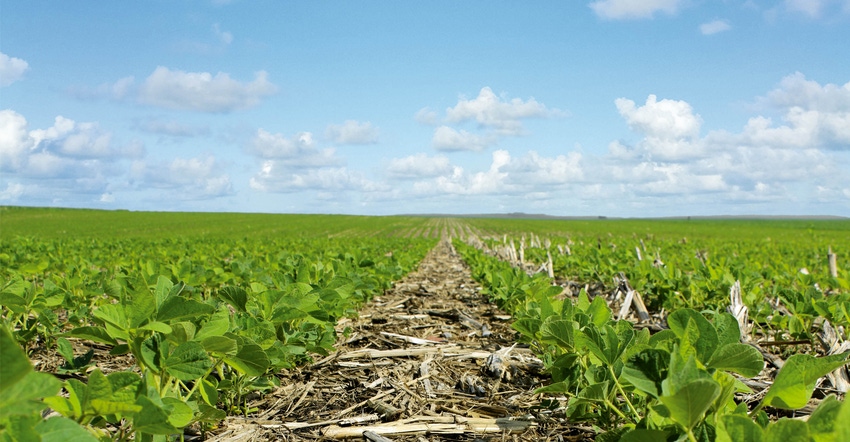October 20, 2021

Most farms are highly complex operations comprised of different landscapes, soil types and land uses. Adding to the complexity are the challenges to maintaining healthy soil and reducing topsoil loss to erosion. And finally, initiatives such as the Iowa Nutrient Reduction Strategy set goals and expectations for reducing nitrate and phosphorus levels in the state’s waterways that largely focus on increased adoption of conservation practices on agricultural lands.
For students in classrooms ranging from high school science and agriculture programs to graduate degree programs at universities, grasping the interdependencies and complexities of what happens on the ground when land management, conservation practice and nutrient management decisions are made, can be equally difficult.
Seeking to provide educational resources to support learning about the sometimes-daunting complexities of conservation and land management practices, Iowa State University’s Conservation Learning Group has published In the Field: Watershed-Based Conservation Case Study Training Kit, the first in a series of four conservation practices case studies.
Real-world look at conservation
This case study includes questions to lead discussions and address the elements that contribute to water quality improvement throughout the Beaver Creek Watershed near Ackley, Iowa. In addition, the materials include detailed descriptions of conservation practices applied at a farm scale and a watershed scale, and how each impacts the watershed and water quality downstream.
Mark Licht, an Iowa State University assistant professor and Extension cropping systems specialist, managed the development and pilot of the case studies with an eye toward bringing the real world into the classroom.
Comprised of a teacher’s guide, a student manual and an extensive set of resources, the In the Field case study presents students with a real-life situation based on an actual farm and watershed in Iowa. Teachers are equipped with information and recommended activities and assignments to elicit the best learning results from students at every learning level. Licht piloted the case study with his graduate level students at ISU in spring 2021 with excellent results.
“As with any pilot program, you expect to make changes, but we were very pleased to see things working as designed — and the feedback on the overall experience was exceptional,” Licht says. “Several of my students were delighted to be able to apply things they had learned in the classroom and see the results borne out by data gathered from the field.”
The In the Field case study presents a detailed description of the subject farming operation, and provides students with a vast array of data sources and reports to use for reference and research. Just like farmers who make decisions to increase productivity and profitability, maintain soil health and manage environmental impacts, students are presented with a situation and expected to:
establish goals
make data-driven decisions regarding practices to implement in particular fields
utilize measurement data and assessment tools to determine changes to nutrient and soil loss
analyze and assess outcomes
reflect on what might make the outcomes better
leave with a better understanding of the complexity of interdependent systems and practices, which together determine the health of a watershed and the quality of water leaving it
“One of our primary goals for these case studies is to make them very teachable and attractive to students who want to dive deep on the interconnectedness of farming, land use, conservation and water quality,” Licht says. “This is not just another textbook with lots of facts and figures. The case study materials include clearly stated prerequisite knowledge; learning objectives appropriate for each education level; and directed activities, from data analysis to outdoor exercises that involve sight and touch senses, to cement comprehension and foster innovative thought processes.”
Beyond the classroom
While the series was developed for formal school curriculum use, there is also potential for the information and exercises to be used in professional training of agricultural advisers and agronomists, as well as for self-study by farmers and landowners looking to dig deeper into the mechanics and potential benefits of specific practices for their farm.
“We feel the case studies will be an excellent complementary resource to the Whole Farm Conservation Best Practices Manual that was published by Iowa State University Extension and Outreach in 2020,” Licht continues. “Farmers may utilize the detailed series of worksheets in the manual to determine what practices might work best for their farm and dig further into the details by working through the case study; or, if the case study details are similar to their own land, might apply what they learned from the case study to working through the decision trees in the whole-farm manual to inform their decisions. In either case, these tools will provide strong guidance that should lead to positive outcomes.”
Licht discussed the In the Field case study in a webinar in August, offering details on the program and showing examples of the data resources and exercises.
Both the case study and the whole farm manual are available free of charge at the following links.
Whole Farm Conservation Best Practices Manual: bit.ly/wholefarmcpnsbp.
In the Field Watershed-Based Conservation Case Study Training Kit: conservationlearninggroup.org. Look for the “Training” heading and then scroll down to the “Educators” section.
The preparation of the case studies involved support and input from many organizations, including USDA Natural Resources Conservation Service and Agricultural Research Service; Iowa Department of Agriculture and Land Stewardship; Practical Farmers of Iowa; Iowa Soybean Association; and the Iowa Agriculture Water Alliance.
Ripley is Iowa Learning Farms manager and a Water Rocks conservation outreach specialist. To learn more about the groups, visit conservationlearninggroup.org.
About the Author(s)
You May Also Like




